Current 2023 road planning and work in Ferndale aims to narrow
Woodward, eliminate lanes, and focus away from automobiles,
but 100 years ago it was quite the opposite!
Prior to 1922, Woodward had been paved with two lanes
in either direction from at least 6 Mile in Detroit past 10 Mile Road.
In 1922 Detroit widened Woodward to 4 lanes in each direction from 6 Mile
to 8 Mile road. Needless to say, this created a large bottleneck of
Northbound vehicles at Ferndale’s gateway!
In 1923 the state approved funding to widen Woodward in Oakland County
with survey work starting soon after followed by grading of the area.
There were countless building disputes and several buildings
had to be moved back from the road - especially in Ferndale’s downtown.
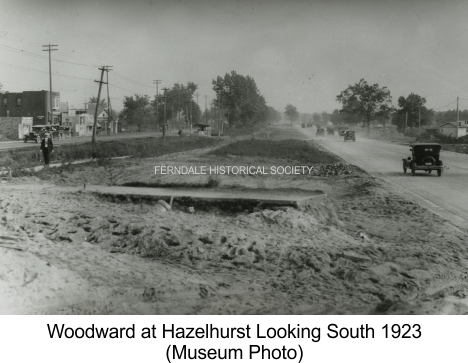
In 1924, the Badder building (where Rust Belt is now) was moved
back several feet. It was also moved north 20 feet to allow for a
wider Nine Mile road. The Aston-Wallace building (still standing
at Woodward and Troy) was also moved back. A more unsettling
situation was the movement of over 350 graves at the
Machpelah cemetery (see below).
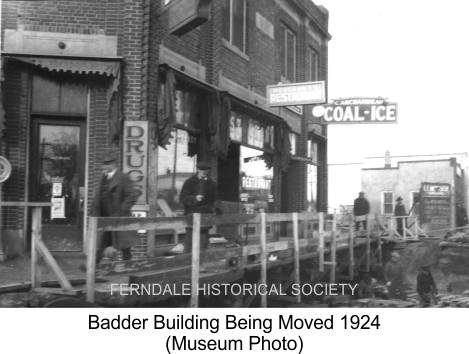
Work on Woodward was aggressive. The first hopper of concrete was
laid by Governor Groesbeck in a celebration at 8 Mile on Wednesday
Aug 6, 1924. There was dancing in the streets as Ferndale held a
celebration on East Nine Mile that night with the Governor attending!
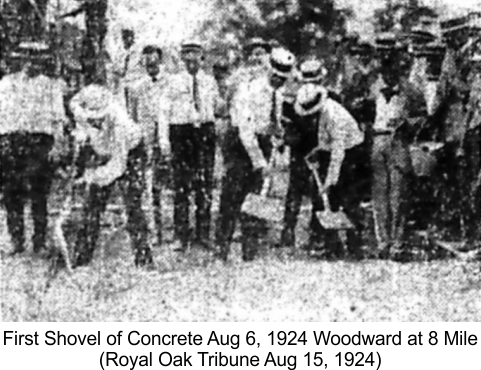
The goal was to finish four lanes (two in either direction) on the
western side of the boulevard, in time for the September State Fair.
That was indeed completed, but not until November 1924
when a celebration was held at 10 Mile and Woodward
with a Mardi-Gras costume theme and more dancing in the streets!
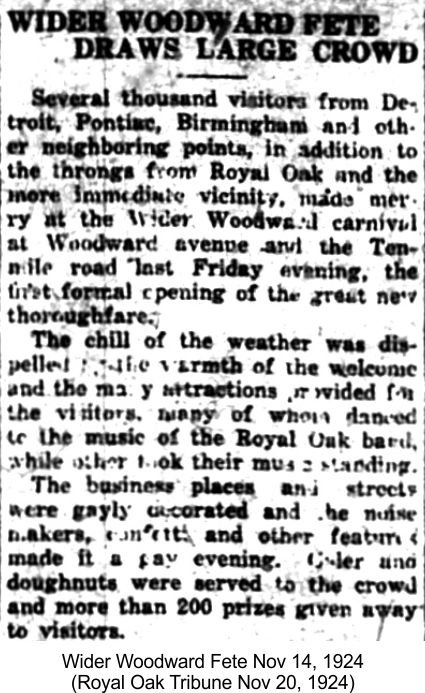
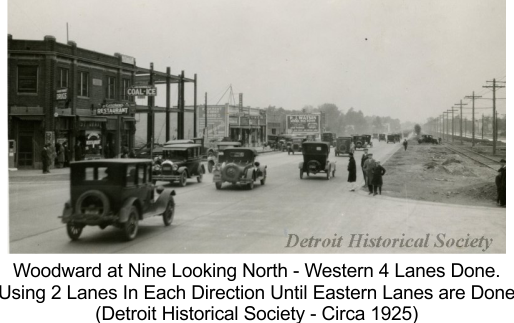
SIDEBAR: A photo from the Royal Oak Historical Society sparked debate and a lot of research by local historical societies. View the results HERE
The Eastern four lanes would not be completed through Ferndale
until Spring of 1926 due to complications re-routing railways.
Similar railway complications meant that both sides of the boulevard
were not completed all the way to Pontiac until 1939.
The original contractor who laid the first mile of concrete on
Woodward in 1909, and built much of the highway from 8 Mile to
Pontiac, was R.D. Baker. He was in attendance 30 years later to
celebrate completion of the "busiest highway in the world"!
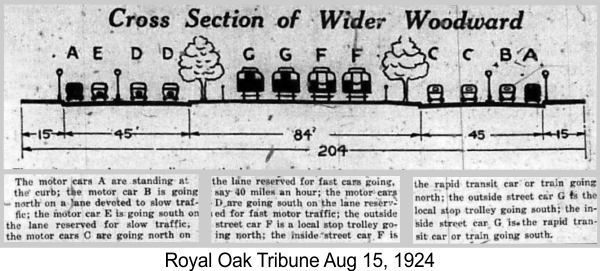
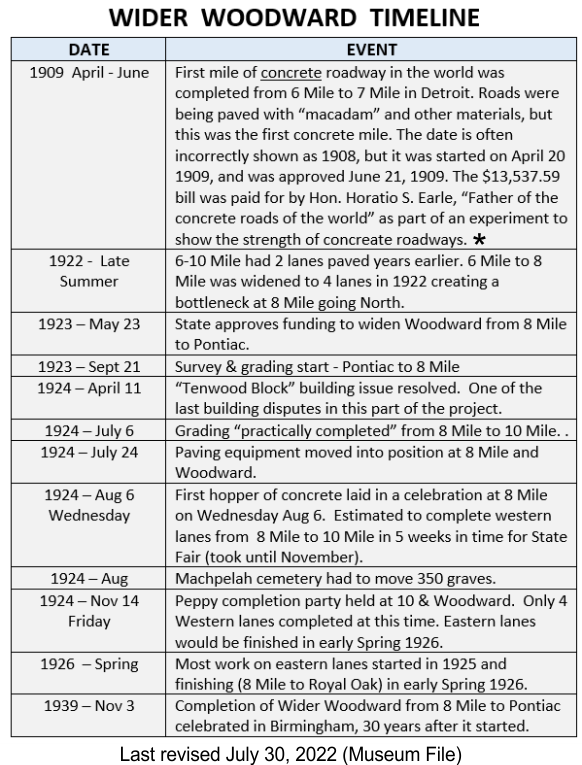
* NOTE: The first concrete roadway in the world was built in Inverness, Scotland, in 1865. Bellefontaine, Ohio is credited with the first portion of concrete road in 1891, then the first block of concrete roadway in 1893. Further history available at the ASCE website HERE.
MACHPELAH CEMETERY’S SACRIFICE
In addition to moving several structures back (or removing them) in 1924
to make way for Wider Woodward, the state had to secure right-of-way
through three local cemeteries Machpelah, Woodlawn near 12 Mile,
and Evergreen south of 8 Mile. All three granted land to
the project, but only Machpelah had to move graves. Below
is an excerpt from an August 8, 1924 article in the Royal Oak Tribune.
“A portion of the Machpelah cemetery, a Jewish burial ground, located at the Eight and a half mile road has been given and three hundred and fifty graves have been moved back to make way for the new highway.
Since the days of Abraham and Sarah, founders of the Jewish race, the last resting place of the dead has been sacred and it was unlawful to molest the tomb. Machpelah cemetery is named for the burial place near Jerusalem of the same Abraham and Sarah.
However loath were the Jews to make this change at Machpelah, they gave way in good will to necessary progress. Three hundred and fifty graves have been removed. The law of the prophets was before them, and since the saving of human life was the only thing which could justify the moving, they decided that a wider Woodward was necessary to save life and limb in traffic.
The cemetery was organized in 1910 by David Oppenheim, the late Samuel Goldstein, and the congregations Beth Jacob and B’nai Israel. The association elected Oppenheim president, and left choice of a site in his hands. Backing was procured from eight additional congregations; Morgane Abraham, Beth braham, Emanuel, Havath Zion, Agudas Schim, Nusache Hari, Beth Tylfilo and the Jewish Old Folks’ Home – all numbering 30,000 persons.
Gov. Alex J. Groesbeck and Thad D. Seeley, the Wider Woodward agent, called in person on Mr. Oppenheim, to enlist his aid in procuring Jewish consent to the plan. When the project of moving the graves was broached, it was bitterly opposed, because of the ancient religious law. With the further development of the case, however they agreed to give the state the ground it wanted, provided the state would give an equal amount of adjacent land.
The state officials readily agreed. It consented also to remove the bodies, to level the cemetery and plant 500 trees and shrubs.
Governor Groesbeck and officials of Ferndale and Oakland county earned the thanks of several congregations for their co-operation in keeping away crowds of morbid curiosity seekers during the moving by posting a police guard at the cemetery, which had been enclosed by a canvas while the removal was being effected. Mr. Oppenheim, whose own Son was one of the first to be buried in the new plot is in charge of the removal by authority of the governor. An elaborate system has been established by him for keeping check of the bodies.”
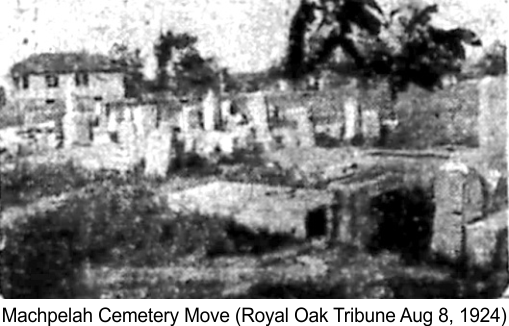
Everyone who has ever used Woodward Avenue near Machpelah
owes a debt of gratitude to the people and permanent residents
of the cemetery who sacrificed to help make Woodward a
safer and more efficient highway!
SEE ALSO
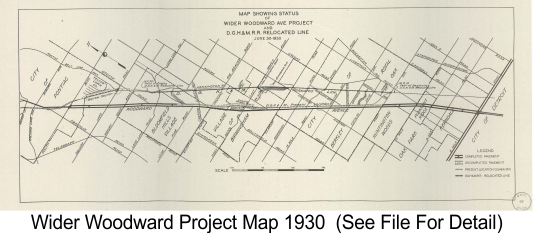
Project maps from a variety of sources
are available HERE
A timeline for M1 events (Circa 1995) is available HERE
A Detroit News slide show about Woodward is available HERE
![]()









